
U.S. Rail Volumes: ‘Mixed’ Bag Lingers in May
Written by Marybeth Luczak, Executive Editor
“Rail traffic volumes in May reflected an economy that is a mixture of good and not-so-good,” Association of American Railroads (AAR) Senior Vice President John T. Gray reported on June 1.
“Auto production and auto carloads seem to be slowly recovering; crushed stone and sand, and food-related volumes are showing strength while intermodal had its best month since June 2021,” Gray noted in the AAR’s rail traffic report for May 2022 and the week ending May 28, 2022. “On the other hand, carloads of chemicals fell for the first time in more than a year in May, while grain volumes continued to be disappointing when compared to those of 2021 and the latter half of 2020.”
In May 2022, seven of the 20 carload commodity categories tracked by the association each month saw carload gains compared with May 2021. These included crushed stone, sand and gravel, up 4,659 carloads or 5.8%; motor vehicles and parts, up 4,534 carloads or 9%; and food products, up 1,652 carloads or 7.1%. Commodities that saw declines in May 2022 from May 2021 included grain, down 13,738 carloads or 13.5%; primary metal products, down 5,878 carloads or 15.3%; and petroleum and petroleum products, down 5,857 carloads or 13.5%.
U.S. railroads originated 928,742 carloads last month, falling 3.7%, or 35,821 carloads, from May 2021. They also originated 1,102,558 containers and trailers, decreasing 4.3%, or 49,258 units, from May 2021. Combined U.S. carload and intermodal originations last month were 2,031,300, down 4%, or 85,079 carloads and intermodal units from 2021.
Excluding coal, carloads were down 30,281 carloads, or 4.3%, in May 2022 from May 2021. Excluding coal and grain, carloads were down 16,543 carloads, or 2.8%.
April 2022 and March 2022 volumes were similar.

What was happening in May of 2019, 2020 and 2021? Let’s review:
May 2019 was “bleak” compared with the same month in 2018. “The current weakness in the rail traffic numbers is due to a combination of factors,” Gray reported on June 5, 2019. “These include flooding in the Midwest that’s been hindering the operations of railroads and many of their customers. More important is heightened economic uncertainty that’s being made worse by increased trade-related tensions; higher tariffs leading to reductions or disruptions of international trade, and lower industrial output. In addition, some rail markets are undergoing rapid change. For example, locally sourced frac sand in Texas is displacing sand that used to be shipped in by rail. Just by themselves, these reduced sand movements are having a material negative impact on total rail carloads.”
U.S. railroads originated 1,291,671 carloads in May 2019, down 2.1%, or 28,065 carloads, from May 2018. U.S. railroads also originated 1,315,684 containers and trailers in May 2019, down 5.9%, or 82,521 units, from the same month in 2018. Combined U.S. carload and intermodal originations in May 2019 were 2,607,355, down 4.1%, or 110,586 carloads and intermodal units from May 2018.
In May 2019, six of the 20 carload commodity categories tracked saw carload gains compared with May 2018. Among these were petroleum and petroleum products, up 13,513 carloads or 25.9%; chemicals, up 2,630 carloads or 1.6%; and nonmetallic minerals, up 2,534 carloads or 12.4%. Among the commodities that saw declines in May 2019 from May 2018 were crushed stone, sand and gravel, down 20,358 carloads or 14.6%; grain, down 6,830 carloads or 5.7%; and primary metal products, down 3,117 carloads or 6.4%.
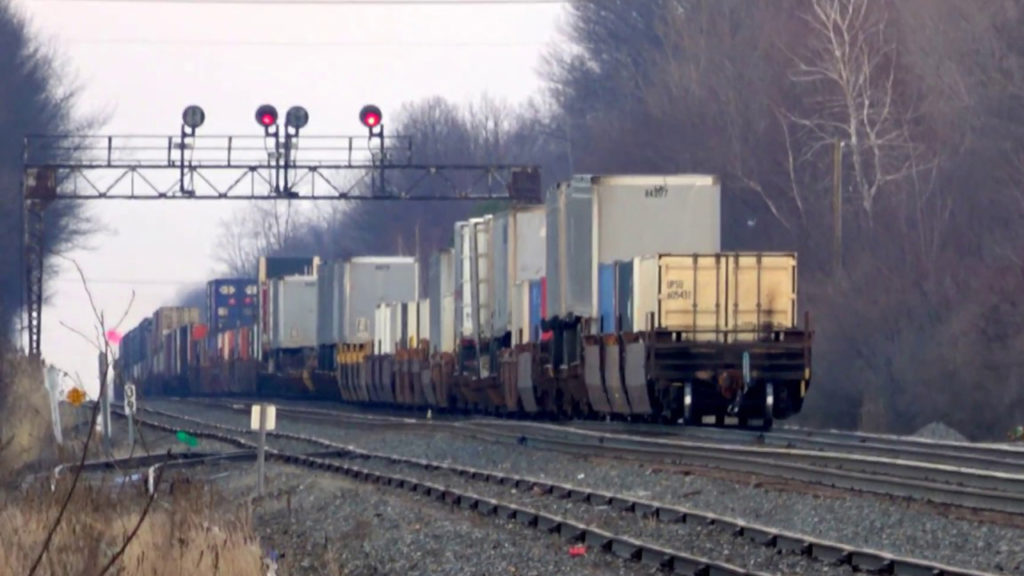
While traffic dropped in May 2020 due to the pandemic, Gray said in AAR’s June 3, 2020 traffic report that there were some “heartening” signs. “Overall traffic levels last week [week ending May 30, 2020] were down from the prior week as would be expected for a week which includes a national holiday,” he reported. “However, it is somewhat heartening to note that 11 of the 20 carload categories, including several major commodity areas, improved their showing vs. 2019 when comparing their current loading rates to those we have seen the last four weeks. Perhaps most notably, automobile loadings improved to about one-third the normal level as assembly plants began the intricate process of reopening. While this is still a long way from where we would like to be, it is far better than the 10% of norm of only two weeks ago.”
U.S. railroads originated 740,171 carloads in May 2020, down 27.7%, or 282,965 carloads, from May 2019. U.S. railroads also originated 912,922 containers and trailers in May 2020, down 13%, or 136,241 units, from the same month in 2019. Combined U.S. carload and intermodal originations in May 2020 were 1,653,093, down 20.2%, or 419,206 carloads and intermodal units from May 2019.
In May 2020, one of the 20 carload commodity categories tracked by the AAR each month saw carload gains compared with May 2019. It was farm products excluding grain, up 324 carloads or 10.6%. Commodities that saw declines in May 2020 from May 2019 were commodities such as coal, down 127,201 carloads or 40.7%; motor vehicles and parts, down 49,341 carloads or 75%; and crushed stone, sand and gravel, down 18,196 carloads or 19.4%.
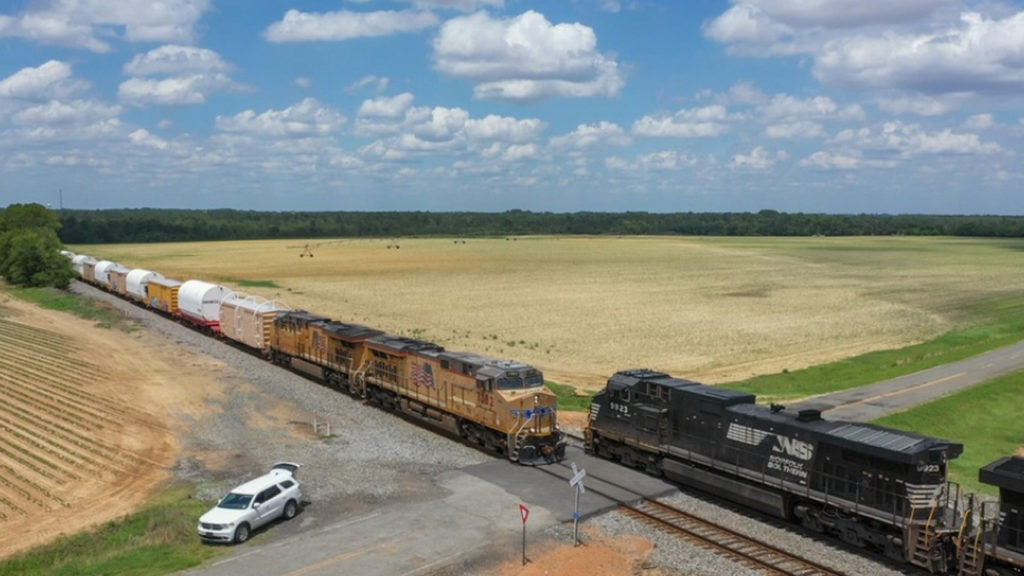
U.S. rail volumes for May 2021 were “encouraging,” he noted. Of the 20 carload categories AAR tracks each month, 12 had gains over May 2019 and 18 had gains over May 2020, near the start of the pandemic. Those 18 included coal, up 77,228 carloads or 41.7%; motor vehicles and parts, up 34,021 carloads or 206.5%; and chemicals, up 23,368 carloads or 20.8%.
“Railroads hope to build on these gains in the months ahead as they help the economy return to strong, sustainable growth,” Gray said.
Commodities that saw declines in May 2021 from May 2020 included farm products excluding grain, down 166 carloads or 4.9%; and primary forest products, down 67 carloads or 1.7%.
U.S. railroads originated 964,356 carloads in May 2021, rising 30.4%, or 224,623 carloads, from May 2020, while they originated 1,151,824 containers and trailers, increasing 26.2%, or 238,927 units. Combined, May 2021’s originations came in at 2,116,180, up 28%, or 463,550 carloads and intermodal units from May 2020.
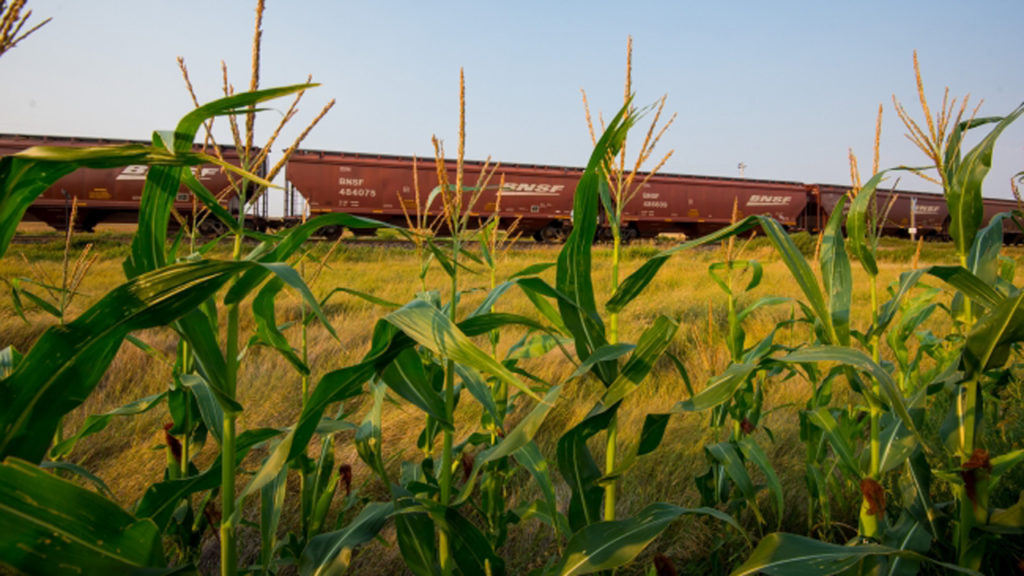
Year to Date 2022
Total U.S. carload traffic for the first five months of 2022 came in at 4,835,705 carloads, up 0.2%, or 8,490 carloads, from the same period last year; and 5,555,607 intermodal units, down 6.6%, or 389,799 containers and trailers.
Total combined U.S. traffic for the first 21 weeks of 2022 was 10,391,312 carloads and intermodal units, a decrease of 3.5% compared with 2021.
Week 21 (Ending May 28, 2022)
Total U.S. weekly rail traffic was 514,277 carloads and intermodal units, a 3% fall-off compared with the same week last year. This is the 14th consecutive week that total traffic has declined. (Total traffic gains were last seen in Week 7, which ended Feb. 17, 2022.)

Total carloads for the week ending May 28, 2022, were 233,633 carloads, down 4% from the same week in 2021, while U.S. weekly intermodal volume was 280,644 containers and trailers, down 2.2% from last year.
Three of the 10 carload commodity groups posted an increase over the same week in 2021. They were farm products excluding grain, and food, up 1,311 carloads, to 16,694; miscellaneous carloads, up 939 carloads, to 11,160; and motor vehicles and parts, up 770 carloads, to 13,708. Commodity groups that posted decreases included grain, down 3,849 carloads, to 21,686; metallic ores and metals, down 3,251 carloads, to 21,109; and coal, down 2,711 carloads, to 63,937.
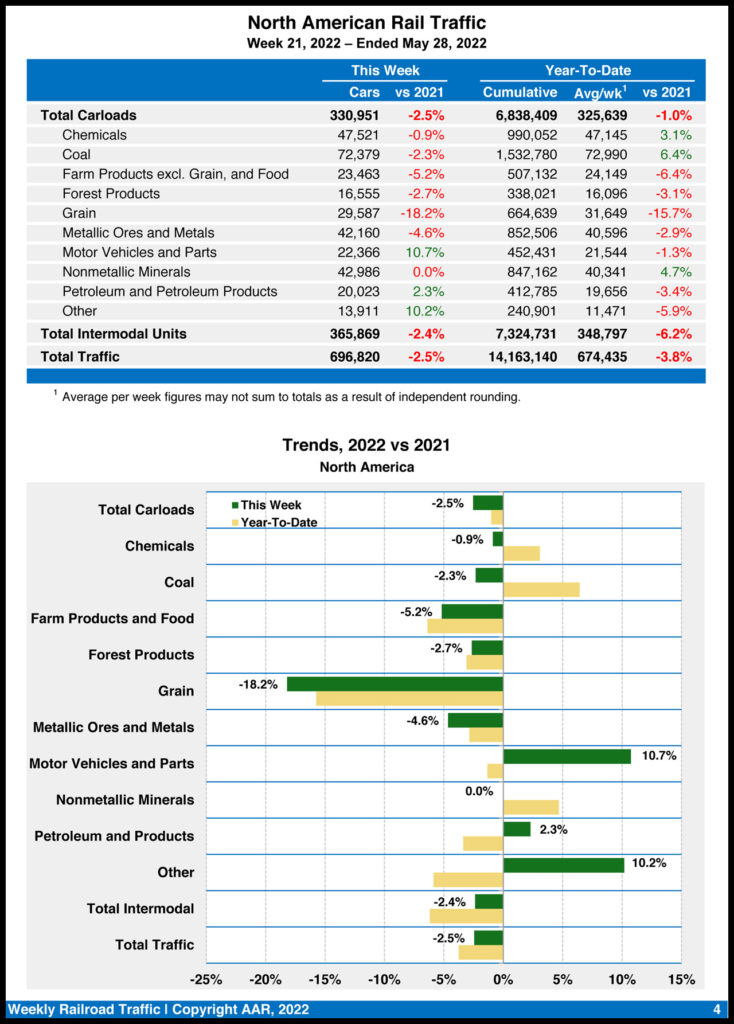
North American rail volume for the week ending May 28, 2022, on 12 reporting U.S., Canadian and Mexican railroads totaled 330,951 carloads, down 2.5% compared with the same week last year, and 365,869 intermodal units, down 2.4%. Total combined weekly rail traffic in North America was 696,820 carloads and intermodal units, dropping 2.5%. North American rail volume for the first 21 weeks of 2022 was 14,163,140 carloads and intermodal units, falling 3.8% from 2021.

Canadian railroads reported 77,381 carloads for the week, up 0.9%, and 70,418 intermodal units, down 3.2% vs. the same week in 2021. For the first 21 weeks of 2022, they reported cumulative rail traffic volume of 2,990,982 carloads, containers and trailers, down 6.1%.
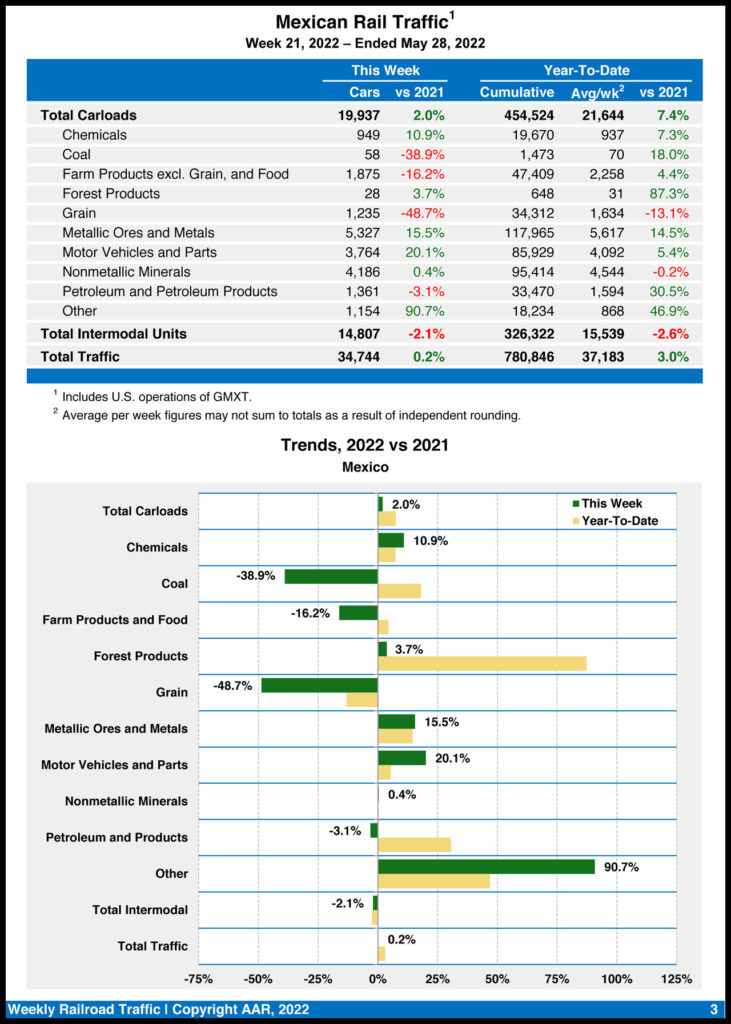
Mexican railroads reported 19,937 carloads for the week, rising 2% from the same week last year, and 14,807 intermodal units, dipping 2.1%. Their cumulative volume for the first 21 weeks of 2022 came in at 780,846 carloads and intermodal containers and trailers, up 3% from the same point in 2021.



